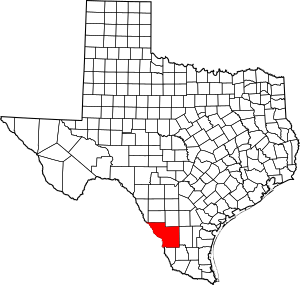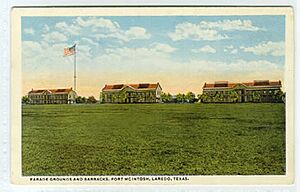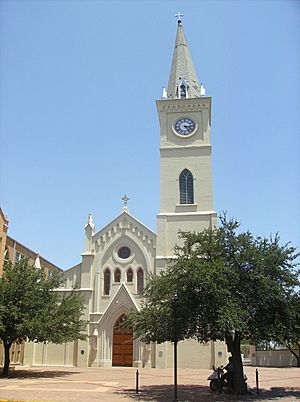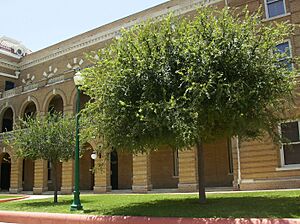National Register of Historic Places listings in Webb County, Texas facts for kids
Have you ever wondered about old buildings and places that are really important to history? In Webb County, Texas, there are many special spots that are officially recognized for their historical value. These places are listed on something called the National Register of Historic Places. It's like a special list kept by the United States government to protect and celebrate important historical sites.
This list helps make sure these places are remembered and taken care of for future generations. Webb County has five historic districts and five individual buildings or sites on this important list. Some of these places are also recognized by the state of Texas as "State Antiquities Landmarks," which means they are extra special!
What is the National Register of Historic Places?
The National Register of Historic Places is the official list of the nation's historic places worthy of preservation. It's part of a national program to coordinate and support public and private efforts to identify, evaluate, and protect America's historic and archaeological resources. When a place is added to this list, it means it's recognized for its importance in American history, architecture, archaeology, engineering, or culture.
Historic Places in Webb County
Let's explore some of the fascinating historic places you can find in Webb County, Texas. Each one tells a unique story about the past!
Barrio Azteca Historic District
- Location: Laredo, Texas
- Listed: May 21, 2003
The Barrio Azteca Historic District is a neighborhood in Laredo that shows off the city's rich history. It's roughly bordered by I-35, Matamoros Street, Arroyo Zacate, and the Rio Grande. This area is important because it represents the cultural heritage and development of Laredo, especially its connection to Mexican traditions and community life. Walking through this district is like taking a step back in time to see how people lived and built their homes in the past.
Fort McIntosh
- Location: Laredo, Texas (on the Laredo Junior College campus)
- Listed: June 25, 1975
Fort McIntosh was once a very important military fort. It was established in 1849 and played a big role in protecting the border and keeping peace in the area. Many different groups of soldiers, including African American "Buffalo Soldiers," were stationed here. Today, the old fort grounds are part of the Laredo College campus. You can still see some of the original buildings, which now serve new purposes for students and the community. It's a great example of how old military sites can be repurposed for education.
Hamilton Hotel
- Location: 815 Salinas Street, Laredo, Texas
- Listed: April 14, 1992
The Hamilton Hotel is a beautiful old building in downtown Laredo. It was built in 1929 and was once a very fancy and popular hotel. Its architecture is quite grand, showing the style of buildings from that time period. Hotels like the Hamilton were important gathering places for travelers and local residents. They often hosted important events and were centers of social life.
Laredo U.S. Post Office, Court House and Custom House
- Location: 1300 Matamoros, Laredo, Texas
- Listed: May 18, 2001
This impressive building served as a post office, a courthouse, and a custom house. It was built in 1905 and is a great example of government architecture from the early 20th century. A custom house is where officials check goods coming into the country, which was very important for Laredo due to its location on the border with Mexico. This building played a key role in the daily lives of people and the economy of the city for many years.
Los Ojuelos Historic District
- Location: About 2.5 miles south of Mirando City on SR 649
- Listed: December 22, 1976
Los Ojuelos is a historic district located outside of the main city areas. It's a rural historic site that helps us understand the early ranching and settlement history of Webb County. These types of districts often include old ranch houses, outbuildings, and land features that show how people lived and worked in the past, especially in agricultural communities.
San Agustin de Laredo Historic District
- Location: Laredo, Texas (roughly bounded by Grant and Water Streets, Convent and San Bernardino Avenues)
- Listed: September 19, 1973
This district is at the very heart of old Laredo. It includes the famous San Agustin Cathedral, which is a beautiful and very old church. This area is important because it was where Laredo first began. It shows the original layout of the city and contains many buildings that reflect its Spanish colonial heritage. Exploring this district helps you imagine what Laredo was like centuries ago.
San Jose de Palafox Historic/Archeological District
- Location: Laredo, Texas (Address Restricted)
- Listed: July 24, 1973
The San Jose de Palafox district is unique because it's both a historic and an archaeological site. This means it's not just about old buildings, but also about what lies beneath the ground. Archaeologists study these sites to find artifacts and clues about ancient civilizations or early settlements. Because of its sensitive nature, the exact address is restricted to protect the site from damage. It holds important information about the very first people who lived in this region.
U.S. Inspection Station
- Location: 100 Convent Avenue, Laredo, Texas
- Listed: September 10, 2014
The U.S. Inspection Station in Laredo is a significant building related to border control and trade. As a major port of entry between the United States and Mexico, Laredo has always had important inspection facilities. This building played a crucial role in managing the flow of people and goods across the border, reflecting the city's unique position as a gateway.
Webb County Courthouse
- Location: 1000 Houston Street, Laredo, Texas
- Listed: May 4, 1981
The Webb County Courthouse is where many important decisions for the county are made. Courthouses are often grand buildings that represent justice and local government. This particular courthouse was built in 1909 and is a beautiful example of early 20th-century architecture. It has been a central part of Webb County's civic life for over a hundred years.








